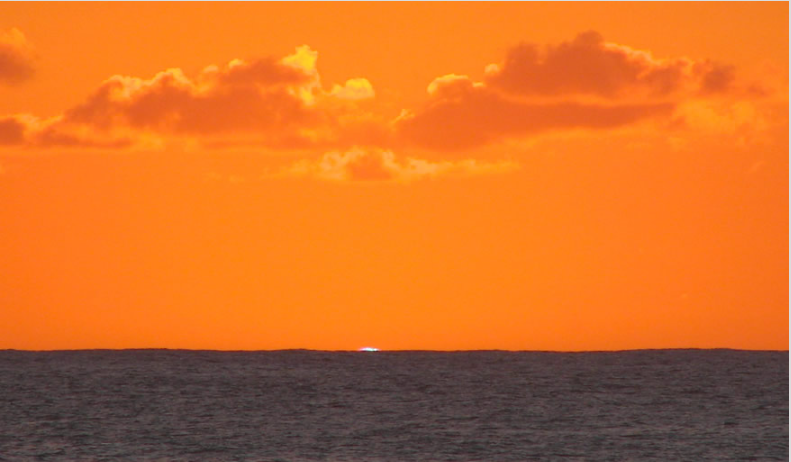Hawaii Oahu Blue Flash
Hawaii Oahu Blue Flash: A Rare and Enigmatic Atmospheric Phenomenon
Have you ever witnessed a breathtaking optical display in the sky? If you're lucky enough to find yourself in Hawaii, specifically on the island of Oahu, you might just catch a glimpse of a mesmerizing phenomenon known as the "Hawaii Oahu Blue Flash." This rare atmospheric event, characterized by a brilliant blue coloration, is a captivating sight that has fascinated skywatchers and scientists alike. In this article, we will delve deeper into the intricacies of this elusive phenomenon, exploring its causes, characteristics, and the scientific explanations behind it.
Understanding the Hawaii Oahu Blue Flash
The Hawaii Oahu Blue Flash is an instance of an atmospheric optical phenomenon called an "I-Mir flash." It occurs during sunset or sunrise when the sun is close to the horizon, creating an ideal setting for light to interact with the atmosphere in peculiar ways. This phenomenon manifests as a brief burst of vibrant blue light that appears just above the sun's disk, tantalizing observers with its ethereal beauty.
The Science Behind the Phenomenon
To comprehend the origins of the Hawaii Oahu Blue Flash, we must delve into the realm of atmospheric optics. The phenomenon is primarily attributed to a combination of atmospheric refraction and scattering processes. Refraction occurs when light bends as it passes through different layers of the atmosphere with varying densities. This bending effect is particularly pronounced near the horizon, where the atmosphere is denser due to its proximity to the Earth's surface.
As sunlight traverses this denser portion of the atmosphere, it undergoes significant refraction, causing the blue portion of the spectrum to deviate more than other colors. Consequently, this separation of colors leads to the emergence of a distinct blue flash above the sun's disk. The blue light observed during this phenomenon is actually sunlight that has been refracted and scattered by atmospheric molecules, creating a stunning visual spectacle.
Mirage Effects and the Bumpy Horizon
In addition to the mesmerizing blue flash, keen observers might notice another intriguing feature: a bumpy horizon. This peculiar effect is likely a result of atmospheric mirages, which occur when light rays are bent by variations in temperature and density within the atmosphere. These bending rays can create distortions, making the horizon appear uneven or wavy.
Mirages are particularly common in regions with significant temperature gradients, such as coastal areas. In the case of the Hawaii Oahu Blue Flash, the presence of mirage effects adds an extra layer of complexity and intrigue to an already captivating phenomenon. The bumpy horizon serves as a testament to the intricate interplay between light and the atmosphere, further enhancing the allure of this rare optical event.
Rarity and Optimal Viewing Conditions
The Hawaii Oahu Blue Flash is an elusive phenomenon that requires specific conditions to occur. Firstly, it is crucial to be in a location where the horizon is unobstructed, allowing for an unimpeded view of the setting or rising sun. Secondly, clear atmospheric conditions are essential to ensure minimal light scattering and optimal visibility. Therefore, individuals situated in areas with minimal air pollution or atmospheric disturbances are more likely to witness this phenomenon.
Furthermore, timing plays a crucial role in observing the Hawaii Oahu Blue Flash. It is most likely to occur during the equinoxes when the sun's path across the sky is nearly perpendicular to the horizon. This alignment maximizes the potential for atmospheric refraction and enhances the chances of witnessing this stunning event.
The Beauty of Nature's Secrets
The Hawaii Oahu Blue Flash serves as a reminder of the beauty and complexity that can be found in nature's subtle secrets. This rare atmospheric phenomenon captivates observers with its vibrant blue coloration and enigmatic nature. As we unravel the scientific explanations behind this optical spectacle, we gain a deeper appreciation for the intricate interplay between light and the atmosphere.
So, if you ever find yourself on the picturesque island of Oahu in Hawaii, keep an eye on the horizon during sunrise or sunset. With a bit of luck and favorable atmospheric conditions, you may be fortunate enough to witness the ethereal beauty of the Hawaii Oahu Blue Flash, a rare phenomenon that leaves spectators in awe of the wonders that lie within our natural world.

Hawaii Oahu flash imaged by David Sanchez (images). This I-Mir flash is a rare blue colour. Note the bumpy horizon which is probably also a mirage effect. ©David Sanchez, shown with permission.
Note: this article has been automatically converted from the old site and may not appear as intended. You can find the original article here.
Reference Atmospheric Optics
If you use any of the definitions, information, or data presented on Atmospheric Optics, please copy the link or reference below to properly credit us as the reference source. Thank you!
-
<a href="https://atoptics.co.uk/blog/hawaii-oahu-blue-flash/">Hawaii Oahu Blue Flash</a>
-
"Hawaii Oahu Blue Flash". Atmospheric Optics. Accessed on December 22, 2024. https://atoptics.co.uk/blog/hawaii-oahu-blue-flash/.
-
"Hawaii Oahu Blue Flash". Atmospheric Optics, https://atoptics.co.uk/blog/hawaii-oahu-blue-flash/. Accessed 22 December, 2024
-
Hawaii Oahu Blue Flash. Atmospheric Optics. Retrieved from https://atoptics.co.uk/blog/hawaii-oahu-blue-flash/.